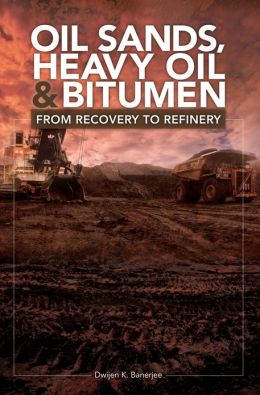
Unlike conventional oil resources, “unconventional” oil resources such as oil sands, heavy oil, and bitumen have been known to exist only for the last few decades and are found primarily in the western United States, Canada, and Venezuela. Only recently has serious consideration has been given to North American resources for meeting the increasing demands for transportation fuel. In this book Dwijen K. Banerjee discusses the importance of these unconventional oils and provides an introduction for those beginning their journey in the still unexplored unconventional hydrocarbon resources of the world. Joel Krupa finds that Banerjee has some excellent conclusions in terms of improvement opportunities.

With the accelerating integration of ‘unconventional’ oil and gas supplies into interconnected global markets, many believe that the complex world of energy policy has changed forever. New geopolitical configurations, environmental impacts, and social structures continue to emerge under this new normal, and some knowledgeable optimists argue that even the most ardent peak oil and peak gas apologists will now need to concede that the market is shifting inexorably towards greater aggregate fossil fuel production as a new cadre of dominant extraction countries are rising to the top. According to these utopians, the problems that the world must now face are not so much those of resource availability (geological assessments suggest that potential global proven, probable, and possible reserves are nearly limitless). Instead, appropriate price points to ensure sufficient extraction are apparently all that stand in our inevitable path towards useful energy ubiquity.
One of the crown jewels sitting at the forefront of this ostensible revolution is the Alberta oil sands. This formation – with origins that date back to the pre-dinosaur Devonian period – covers 50,000 square kilometers of mostly boreal forest, and is comprised of four distinct collections of bitumen known as the Athabasca, Cold Lake, Peace River, and Wabasca deposits. The sheer energy content available here is mind-warping; for example, established reserves (less than a tenth of one recent estimate of theoretically extractable reserves, according to the provincial ministry that oversees them) in this area represent energy stores only moderately less than undisputed oil kingpin Saudi Arabia. Predictably, oilmen around the world are salivating at the prospects of this frigid goldmine (see Pickens’ The First Billion is the Hardest), and development – especially prior to the economic collapse of 2008 – has proceeded at a breakneck pace.
Like most alluring visions, this dream comes laden with unfortunate difficulties that, too often, go unaddressed by the apologists. Can oil sands/heavy oil/bitumen be mined or recovered through steam injection in an environmentally sustainable way that does not compromise valuable freshwater supplies? Does it pass the test of resource stewardship probity to consume vast quantities of comparatively clean natural gas for oil sands extraction? And what about refining, as pipeline logistics and different blends of bitumen require substantial modifications to extant infrastructures? Most importantly of all, can responsible solutions be realized that would placate both moderate environmentalists and profit-oriented corporations?
In the technically rigorous new Pennwell release Oil Sands, Heavy Oil and Bitumen: From Recovery to Refinery, these questions and others are systematically addressed. Author Dwijen K. Banerjee’s decades-long research and development experience with heavy oil, bitumen characterization, processing and synthetic crude upgrading is clearly visible as he probes the nuances of this multi-faceted issue. The gamut of relevant topics – bitumen chemistry, deposit information for extraheavy oil, upgrading technologies, transportation configurations, and the prospects for the alternatives – are all dealt with using a clear, engaging, and (usually) surprisingly readable writing style. No tars sands commentary (a common pejorative label slapped on by environmentalists around the world) will be found here; helpfully, Banerjee clarifies from the onset that the ‘tar sands’ classification is scientifically incorrect, as he explains that “[tar sands] terminology should be avoided because oil sands are neither tar nor sands…tar is not a raw material; instead, it is a residual product that remains after severe thermal cracking of heavy oil”.
It should be noted by prospective readers that this text, intended for “petroleum industry engineers, R&D researchers, refiners, junior and senior-level managers, and graduate students in chemical engineering, petroleum, and petroleum chemistry”, is not for everyone. Even though substantive matters clock in at fewer than 160 pages, the prose can be a bit tough for non-technical readers to get through at times, and the writing balance would certainly have benefitted from more sociopolitical and economic coverage of the issues. Detail-averse perusers in particular should beware: Banerjee does not shy away from quantitative analysis (everything from bitumen viscosity formulas to processing calculations) or information tables. Broad strokes can obviously never be unreservedly painted, but it is safe to say that some chapters are certain to garner more interest than others; analytical techniques, for example, will likely elicit involuntary yawns in all but the heartiest bibliophiles, while sections like “recovery to refinery” are broadly intellectually engaging.
Given the importance of the topic, however, any difficulties are worth enduring, and all readers should glean much new information (corroborated by an obvious scientific competency). The unique characteristics of bitumen – very low API gravity, high viscosity, and high sulfur concentrations – bring their own suite of unique challenges, and Banerjee is no unequivocal apologist. Bitumen is, in his words, “an extremely poor-quality oil”, and enormous amounts of earth, energy, water, and human capital must be expended to extract it. Current processes are not sufficient to ensure that this is done in a holistically sustainable way – Banerjee’s focus here zeroes in on the environmental aspects, and he sees many facets as ripe for change. Unfortunately, he does not explore the case for non-nuclear renewable or clean alternatives; regrettable indeed, especially when one considers the fearsome consequences of business-as-usual anthropogenic climate change and the ample renewables potential in Western Canada.
Even though he doesn’t go far enough, Banerjee has some excellent conclusions in terms of improvement opportunities. First, he argues that we should use the natural gas combusted in oil sands processing for superior uses – a case that has been argued in alternate fora. He also highlights the role that nuclear can play; for example, he contends that bitumen can be produced through the deployment of “a nuclear reactor of capacity 1,000 megawatts electrical (MWe)…[that will] produce enough steam for a SAGD operation …[of] 300,000 [barrels].” Missing is extensive discussion of water usage reductions, but this is also crucial. Although these preliminary steps still do not fully address the (largely unaddressed) climate change implications and technological lock-in considerations voiced by others, they are a move in the right direction.
At the end of the day, it is hard to deny that unconventional sources like oil sands will be essential for the economies of the near-term to mid-term future. Muller, in Energy for Future Presidents, for instance, has pointed out that we are in the midst of a potent transportation fuels crisis that shows no signs of abating. The reasons for this are sound – oil has an outstanding power density, innate flexibility, a hard-to-replicate clean burn in an engine, a relatively rapid fill rate, trillions of dollars in fossil-dependent embedded infrastructure, and a variety of subsidies that perpetuate an incumbent advantage. However, we cannot rely on unconventional sources as they are currently produced to meet our needs. Climate change, widespread freshwater depletion, and cheap fossil fuel scarcity are on the horizon; if improperly approached, oil sands threaten to exacerbate all three. These questions are not going away, so readers wishing to make an informed contribution to the incredibly contentious debates swirling around these sands would do well to pick up this tome.
—————————————————–
Joel Krupa is an energy and environment researcher at the University of Toronto, studying under Dr. Danny Harvey. He was educated at Oxford. Read more reviews by Joel.








1 Comments